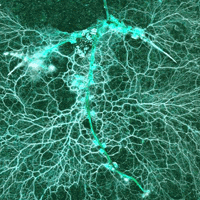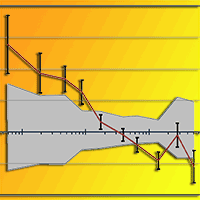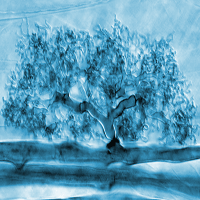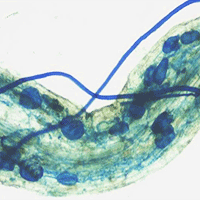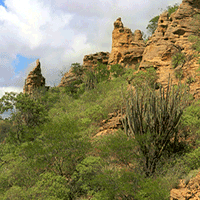Effects of soil chemical properties on arbuscular mycorrhizal fungal (AMF) symbiosis with wild service tree (Sorbus torminalis L. Crantz) were examined for study the rates of root colonization at three forest sites: Kheiroud, Lalis, and Takrin in northern Iran. Soil characteristics including pH, available phosphorus (P), potassium (K), organic matter, total nitrogen, acid and alkaline phosphatase activities, CaCO3, spore density (SD) and AMF colonization of soil and root samples were analyzed. The study sites were investigated in spring and autumn to highlight the effects of soil chemical properties on AMF statues for better nurseries and reforestation management of this rare tree species in forests. Changes in soil pH, P, K, organic matter, total nitrogen, acid and alkaline phosphatase, CaCO3, SD, and AMF colonization of soil and root samples were analyzed at the study sites. K, pH, root colonization, SD and acid phosphatase activity showed no significant differences among sites in spring and autumn, while total nitrogen, P, organic matter and alkaline phosphatase activities showed significant differences among sites and seasons. AMF colonization rates were more than 51% and 32% of roots in spring and autumn, respectively. No correlation between root colonization and soil chemical parameters in spring and autumn were detected. There was no correlation between percentage of AM root colonization and SD nor other soil parameters in spring and autumn. SD and CaCO3 were significantly negatively correlated in spring and autumn. Despite differences in soil characteristics, the results showed that SD and root colonization were not significantly different among the sites. They also showed that wild service trees had strong symbiosis with AMF, while soil properties might not have a significant effect on this symbiosis. Therefore, colonized seedlings can be considered as an appropriated method for reforestation and conservation of this rare tree species.
Keywords
, , , ,
Citation
Moradi M, Shirvany A, Matinizadeh M, Etemad V, Naji HR, Abdul-Hamid H, Sayah S (2015). Arbuscular mycorrhizal fungal symbiosis with Sorbus torminalis does not vary with soil nutrients and enzyme activities across different sites. iForest 8: 308-313. - doi: 10.3832/ifor1236-008
Academic Editor
Gianfranco Minotta
Paper history
Received: Jan 06, 2014
Accepted: May 24, 2014
First online: Sep 03, 2014
Publication Date: Jun 01, 2015
Publication Time: 3.40 months
© SISEF - The Italian Society of Silviculture and Forest Ecology 2015
Open Access
This article is distributed under the terms of the Creative Commons Attribution-Non Commercial 4.0 International (https://creativecommons.org/licenses/by-nc/4.0/), which permits unrestricted use, distribution, and reproduction in any medium, provided you give appropriate credit to the original author(s) and the source, provide a link to the Creative Commons license, and indicate if changes were made.

Breakdown by View Type
(Waiting for server response...)
Article Usage
Total Article Views: 55849
(from publication date up to now)
Breakdown by View Type
HTML Page Views: 45232
Abstract Page Views: 4221
PDF Downloads: 4938
Citation/Reference Downloads: 16
XML Downloads: 1442
Web Metrics
Days since publication: 4118
Overall contacts: 55849
Avg. contacts per week: 94.94
Article Citations
Article citations are based on data periodically collected from the Clarivate Web of Science web site
(last update: Mar 2025)
Total number of cites (since 2015): 13
Average cites per year: 1.18
Publication Metrics
by Dimensions ©
Articles citing this article
List of the papers citing this article based on CrossRef Cited-by.
(1)
Amaya-Carpio L, Davies FTJr, Fox T, He C (2009)Arbuscular mycorrhizal fungi and organic fertilizer influence photosynthesis, root phosphatase activity, nutrition, and growth of
Ipomoea carnea ssp.
fistulosa. Photosynthetica 47 (1): 1-10.
CrossRef |
Gscholar
(2)
Barea JM, Palenzuela J, Cornejo P, Sánchez-Castro I, Navarro- Fernández C, Lopéz-arcía A, Estrada B, Azcón R, Ferrol N, Azcón-Aguilar C (2011)Ecological and functional roles of mycorrhizas in semi-arid ecosystems of Southeast Spain. Journal of Arid Environments 75 (12): 1292-1301.
CrossRef |
Gscholar
(3)
Basumatary A, Bordoloi PK (1992)Forms of potassium in some soils of Assam in relation to soil properties. Journal of the Indian Society of Soil Science 40 (3): 443-446.
Gscholar
(4)
Becerra GA, Cabello M, Zak RM, Bartoloni N (2009)Arbuscular mycorrhizae of dominant plant species in Yungas forests, Argentina. Mycologia 101 (5): 612-621.
CrossRef |
Gscholar
(5)
Bremner JM, Mulvaney CS (1982)Nitrogen total. In: “Method of soil analysis - part 2: chemical and microbiological methods (2nd edn)” (Miller RH, Kieney DR eds). Agronomy series no. 9, American Society for Agronomy and Soil Sciences, Madison, WI, USA, pp. 595-624.
Gscholar
(6)
Closa I, Goicoechea N (2011)Infectivity of arbuscular mycorrhizal fungi in naturally regenerating, unmanaged and clear-cut beech forests. Pedosphere 21 (1): 65-74.
CrossRef |
Gscholar
(7)
Dai W, Huang Y (2006)Relation of soil organic matter concentration to climate and altitude in zonal soils of China. Catena 65: 87-94.
CrossRef |
Gscholar
(8)
Dick WA, Cheng L, Wang P (2000)Soil acid and alkaline phosphatase activity as pH adjustment indicators. Soil Biology and Biochemistry 32 (13): 1915-1919.
CrossRef |
Gscholar
(9)
Dick WA, Tabatabai MA (1984)Kinetic parameters of phosphatases in soils and organic waste materials. Soil Science 137 (1): 7-15.
CrossRef |
Gscholar
(10)
Gai JP, Tian H, Yang FY, Christie P, Li XL, Klironomos JN (2012)Arbuscular mycorrhizal fungal diversity along a Tibetan elevation gradient. Pedobiologia 55: 145- 151.
Gscholar
(11)
Gairola S, Sharma CM, Ghildiyal SK, Suyal S (2012)Chemical properties of soils in relation to forest composition in moist temperate valley slopes of Garhwal Himalaya, India. The Environmentalist 32 (4): 512-523.
CrossRef |
Gscholar
(12)
Gerdemann J, Nicolson T (1963)Spores of mycorrhizal Endogone species extracted from soil by wet sieving and decanting. Transactions of the British Mycological Society 46 (2): 235-244.
CrossRef |
Gscholar
(13)
Giovannetti M, Mosse B (1980)An evaluation of techniques for measuring vesicular-arbuscular mycorrhizal infection in roots. New Phytologist 84 (3): 489-500.
CrossRef |
Gscholar
(14)
Griffiths RP, Madritch MD, Swanson AK (2009)The effects of topography on forest soil characteristics in the Oregon Cascade Mountains (USA): implications for the effects of climate change on soil properties. Forest Ecology and Management 257 (1): 1-7.
CrossRef |
Gscholar
(15)
Guilford JP (1973)Fundamental statistics in psychology and education. McGraw-Hill, New York, USA, pp. 546.
Gscholar
(16)
Hamman ST, Burke IC, Knapp EE (2008)Soil nutrients and microbial activity after early and late season prescribed burns in a Sierra Nevada mixed conifer forest. Forest Ecology and Management 256 (3): 367-374.
CrossRef |
Gscholar
(17)
Hisinger P (2001)Bioavailability of soil inorganic P in the rhizosphere as affected by root-induced chemical changes: a review. Plant and Soil 237 (2): 173-195.
CrossRef |
Gscholar
(18)
Hrynkiewicz K, Baum C, Leinweber P (2009)Mycorrhizal community structure, microbial biomass P and phosphatase activities under
Salix polaris as influenced by nutrient availability. European Journal of Soil Biology 45 (2): 168-175.
CrossRef |
Gscholar
(19)
Huang H, Zhang S, Wu N, Luo L, Christie P (2009)Influence of
Glomus etunicatum /
Zea mays mycorrhiza on atrazine degradation, soil phosphatase and dehydrogenase activities, and soil microbial community structure. Soil Biology and Biochemistry 41 (4): 726-734.
CrossRef |
Gscholar
(20)
Isobe K, Aizawa E, Iguchi Y, Ishii R (2007)Distribution of arbuscular mycorrhizal fungi in upland field soils of Japan. 1. Relationship between spore density and the soil environmental factor. Plant Production Science 10 (1): 122-128.
CrossRef |
Gscholar
(21)
Kane ES, Valentine DW, Schuur EA, Dutta K (2005)Soil carbon stabilization along climate and stand productivity gradients in black spruce forests of interior Alaska. Canadian Journal of Forest Research 35 (9): 2118-2129.
CrossRef |
Gscholar
(22)
Kirschbaum MUF (1995)The temperature dependence of soil organic matter decomposition, and the effect of global warming on soil organic storage. Soil Biology and Biochemistry 27 (6): 753-760.
CrossRef |
Gscholar
(23)
Kivlin SN, Hawkes CV, Treseder KK (2011)Global diversity and distribution of arbuscular mycorrhizal fungi. Soil Biology and Biochemistry 43 (11): 2294-2303.
CrossRef |
Gscholar
(24)
Labidi S, Calonne M, Ben JF, Debiane D, Rezgui S, Laruelle F, Tisserant B, Ferjani GA, Lounès HSA (2011)Calcareous impact on arbuscular mycorrhizal fungus development and on lipid peroxidation in monoxenic roots. Phytochemistry 72: 2335-2341.
CrossRef |
Gscholar
(25)
Li LF, Yang AN, Zhao ZW (2005)Seasonality of arbuscular mycorrhizal symbiosis and dark septate endophytes in a grassland site in southwest China. FEMS Microbiology Ecology 54: 367-373.
CrossRef |
Gscholar
(26)
Liu J, Wu L, Wei S, Xiao X, Su C, Jiang P, Song Z, Wang T, Yu Z (2007)Effects of arbuscular mycorrhizal fungi on the growth, nutrient uptake and glycyrrhizin production of licorice (
Glycyrrhiza uralensis Fisch). Plant Growth Regulation 52 (1): 29-39.
CrossRef |
Gscholar
(27)
Marschner H, Dell B (1994)Nutrient uptake in mycorrhizal symbiosis. Plant and Soil 59: 89-102.
Online |
Gscholar
(28)
Matevz L, Katarina H, Tomislav R, Marjana R (2013)Distribution and diversity of arbuscular mycorrhizal fungi in grapevines from production vineyards along the eastern Adriatic coast. Mycorrhiza 23 (3): 209-219.
CrossRef |
Gscholar
(29)
Mendoza RE, Goldmann V, Rivas J, Escudero V, Pagani E, Collantes MB, Marbán L (2002)Arbuscular mycorrhizal fungi populations in relationship with soil properties and host plant in grasslands of Tierra del Fuego. Ecologia Austral 12: 105-116.
Gscholar
(30)
Minggui G, Ming T, Qiaoming Z, Xinxin F (2012)Effects of climatic and edaphic factors on arbuscular mycorrhizal fungi in the rhizosphere of
Hippophae rhamnoides in the Loess Plateau, China. Acta Ecologica Sinica 32 (2): 62-67.
CrossRef |
Gscholar
(31)
Moreira M, Baretta D, Mui TS, Cardoso EJBN (2006)Spore density and root colonization by arbuscular mycorrhizal fungi in preserved or disturbed
Araucaria angustifolia (Bert.) O. Ktze. ecosystems. Scientia Agricola 63 (4): 380-385.
CrossRef |
Gscholar
(32)
Morwin HD, Peach PM (1951)Exchangeability of soil potassium in and, silt and clay fractions as influenced by the nature of complementary exchangeable cations. Soil Science Society of America Journal 15: 125-128.
CrossRef |
Gscholar
(33)
Motosugi H, Yamamoto Y, Naruo T, Kitabyashi H, Ishi T (2002)Comparison of the growth and leaf mineral concentrations between three grapevine rootstocks and their corresponding tetraploids inoculated with an arbuscular mycorrhizal fungus
Gigaspora margarita. Vitis 41:21-25.
Online |
Gscholar
(34)
Muthukumar T, Sha LQ, Yang XD, Cao M, Tang JW, Zheng Z (2003)Distribution of roots and arbuscular mycorrhizal associations in tropical forest types of Xishuangbanna, southwest China. Applied Soil Ecology 22 (3): 241-253.
CrossRef |
Gscholar
(35)
Nicolescu VN, Hochbichler E, Coello Gomez J, Ravagni S, Giulietti V (2009)Ecology and silviculture of wild service tree (
Sorbus torminalis (L.) Crantz): a literature review. Die Bodenkultur 60 (3): 35-44.
Online |
Gscholar
(36)
Ohlinger R (1996)Acid and alkaline phosphomonoesterase activity with the substrate p-nitrophenyl phosphate. In: “Methods in Soil Biology” (Schinner F, Kandeler E, Ohlinger R, Margesin RE eds). Springer-Verlag, Berlin, Germany, pp. 210-214.
Gscholar
(37)
Olsen SR, Cole CV, Watanabe FS, Dean LA (1954)Estimation of available phosphorus in soils by extraction with sodium bicarbonate. USDA Circular 939: 1-19.
Gscholar
(38)
Paganová V (2008)Ecological requirements of wild service tree (
Sorbus torminalis [L.] Crantz.) and service tree (
Sorbus domestica L.) in relation with their utilization in forestry and landscape. Journal of Forest Science 54 (5): 216-226.
Gscholar
(39)
Paudel S, Sah JP (2003)Physiochemical characteristics of soil in tropical Sal (
S. robusta Gaertn) forest in eastern Nepal. Himalayan Journal of Sciences 1 (2): 107-110.
Online |
Gscholar
(40)
Phillips JM, Hayman DS (1970)Improved procedures for clearing and staining parasitic and vesicular-arbuscular mycorrhizal fungi for rapid assessment of infection. Transactions of the British Mycological Society 55 (1): 158-161.
CrossRef |
Gscholar
(41)
Pourmajidian M (2000)A study on the silvicultural characteristics and reproduction methods of
Sorbus torminalis (L.) Crantz in western Mzandaran (Iran). PhD thesis, University of Tarbiyat Modares, Tehran, Iran, pp. 257.
Gscholar
(42)
Quideau SA (2002)Organic matter accumulation. In: “Encyclopedia of Soil Science”. Marcel Dekker Inc., New York, USA, pp. 891-894.
Gscholar
(43)
Raspe O, Findlay C, Jacquemart AL (2000)Sorbus aucuparia L. Journal of Ecology 88 (5): 910-930.
CrossRef |
Gscholar
(44)
Redecker D, Kodner R, Graham LE (2000)Glomalean fungi from the Ordovician. Science 289: 1920-1921.
CrossRef |
Gscholar
(45)
Rodriguez-Echeverria S, Gera Hol WH, Freitas H, Eason WR, Cook R (2008)Arbuscular mycorrhizal fungi of
Ammophila arenaria (L.) Link: Spore abundance and root colonization in six locations of the European coast. European Journal of Soil Biology 44 (1): 30-36.
CrossRef |
Gscholar
(46)
Rooney DC, Prosser JI, Bending GD, Baggs EM, Killham K, Hodge A (2011)Effect of arbuscular mycorrhizal colonisation on the growth and phosphorus nutrition of
Populus euramericana c.v. Ghoy. Biomass and Bioenergy 35 (11): 4605-4612.
CrossRef |
Gscholar
(47)
Sardans J, Penuelas J, Ogaya R (2008)Experimental drought reduced acid and alkaline phosphatase activity and increased organic extractable P in soil in a
Quercus ilex Mediterranean forest. European Journal of Soil Biology 44 (5-6): 509-520.
CrossRef |
Gscholar
(48)
Smith SE, Read DJ (1997)Mycorrhizal symbiosis (2nd ed). Academic Press, San Diego, USA, pp. 605.
Gscholar
(49)
Smith SE, Read DJ (2008)Mycorrhizal symbiosis. Academic Press Inc., London, UK, pp. 800.
Gscholar
(50)
Smith SE, Smith, FA, Jakobsen I (2003)Mycorrhizal fungi can dominate phosphate supply to plants irrespective of growth responses. Plant Physiology 133 (1): 16-20.
CrossRef |
Gscholar
(51)
Thonar C, Schnepf A, Frossard E, Roose T, Jansa J (2011)Traits related to differences in function among three arbuscular mycorrhizal fungi. Plant and Soil 339 (1-2): 231-245.
CrossRef |
Gscholar
(52)
Treseder KK (2004)A meta-analysis of mycorrhizal responses to nitrogen, phosphorus and atmospheric CO
2 in field studies. New Phytologist 164 (2): 347-355.
CrossRef |
Gscholar
(53)
Van der Heijden MGA, Klironomos JN, Ursic M, Moutoglis P, Streitwolf-Engel R, Boller T, Wiemken A, Sanders IR (1998)Mycorrhizal fungal diversity determines plant biodiversity, ecosystem variability and productivity. Nature 396 (6706): 69-72.
CrossRef |
Gscholar
(54)
Walkley A, Black IA (1934)An examination of the Degtjareff method for determining organic carbon in soils: effect of variations in digestion conditions and of inorganic soil constituents. Soil Science 63 (4): 251-264.
CrossRef |
Gscholar
(55)
Waltert B, Wiemken V, Rusterholz H., Boller T, Baur B (2002)Disturbance of forest by trampling: effects on mycorrhizal roots of seedlings and mature trees of Fagus sylvatica. Plant and Soil 243 (2): 143-154.
CrossRef |
Gscholar
(56)
Wu Q, Zou YN, He XH (2011)Differences of hyphal and soil phosphatase activities in drought-stressed mycorrhizal trifoliate orange (
Poncirus trifoliata) seedlings. Scientia Horticulturae 129: 294-298.
CrossRef |
Gscholar
(57)
Xu P, Christie P, Liu Y, Zhang J, Li X (2008)The arbuscular mycorrhizal fungus
Glomus mosseae can enhance arsenic tolerance in
Medicago truncatula by increasing plant phosphorus status and restricting arsenate uptake. Environmental Pollution 156 (1): 215-220.
CrossRef |
Gscholar
(58)
Yong SZ, Chao ZC, Yun LZ, Gu F, Peter C, Yan CT, Lin XL (2007)Diversity and zonal distribution of arbuscular mycorrhizal fungi on the northern slopes of the Tianshan Mountains. Sci China Ser D-Earth Sci 50: 135-141.
Gscholar
(59)
Zhao J, Dong Y, Xie X, Li X, Zhang X, Shen X (2011)Effect of annual variation in soil pH on available soil nutrients in pear orchards. Acta Ecologica Sinica 31 (4): 212-216.
CrossRef |
Gscholar
